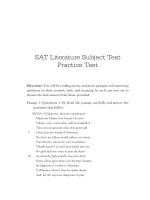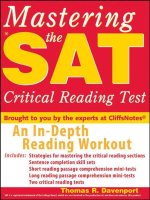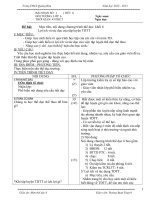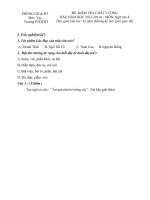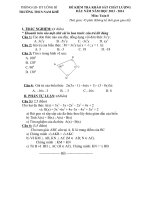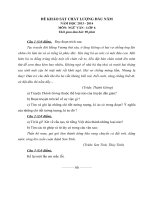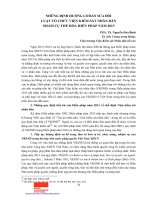Cracking the SAT physics subject test, 2013 2014 edition review, princeton
Bạn đang xem bản rút gọn của tài liệu. Xem và tải ngay bản đầy đủ của tài liệu tại đây (8.75 MB, 590 trang )
Editorial
Rob Franek, Senior VP, Publisher
Mary Beth Garrick, Director of Production
Selena Coppock, Senior Editor
Calvin Cato, Editor
Kristen O’Toole, Editor
Meave Shelton, Editor
Random House Publishing Team
Tom Russell, Publisher
Nicole Benhabib, Publishing Director
Ellen L. Reed, Production Manager
Alison Stoltzfus, Managing Editor
The Princeton Review, Inc.
111 Speen Street, Suite 550
Framingham, MA 01701
E-mail:
Copyright © 2013 by TPR Education IP Holdings, LLC.
Cover art © Jonathan Pozniak
All rights reserved. Published in the United States by Random House, Inc., New York, and in Canada by Random House of
Canada Limited, Toronto.
eBook ISBN: 978-0-307-94575-4
Trade Paperback ISBN: 978-0-307-94555-6
SAT is a registered trademark of the College Board, which does not sponsor or endorse this product.
The Princeton Review is not affiliated with Princeton University.
Editor: Meave Shelton
Production Editor: Kiley Pulliam
Production Artist: Craig Patches
2013–2014 Edition
v3.1
Acknowledgments
My thanks and appreciation to John Katzman, Steve Quattrociocchi, Jeff Rubenstein, Kris
Gamache, Dan Edmonds, and Suellen Glasser, for making me feel at home; to Rachel
Warren, Kate O’Neill, Melissa Kavonic, and Jeff Soloway for their support and fantastic
editing, and to the production team for their beautiful work. Thanks to Paul Kanarek for his
friendship, counsel, and encouragement.
Special thanks to Douglas Laurence for his work on the latest revision of this book.
A special thanks to Adam Robinson, who conceived of and perfected the Joe Bloggs
approach to standardized tests and many of the other successful techniques used by The
Princeton Review.
Dedication
This work is dedicated to the memory of my great aunt, Norma Perron Lamb Piette.
Contents
Cover
Title Page
Copyright
Acknowledgments
Dedication
Introduction
1 Math Review
Basic Trig Review
Vectors
2 Kinematics
Displacement
Speed and Velocity
Acceleration
Uniformly Accelerated Motion and the Big Five
Kinematics with Graphs
Free Fall
Projectile Motion
Chapter 2 Review Questions
3 Newton’s Laws
The First Law
The Second Law
The Third Law
Newton’s Law of Gravitation
The Gravitational Attraction Due to an Extended Body
Weight
The Normal Force
Friction
Pulleys
Inclined Planes
Chapter 3 Review Questions
4 Work, Energy, and Power
Work
Work Done by a Variable Force
Kinetic Energy
The Work–Energy Theorem
Potential Energy
Gravitational Potential Energy
Conservation of Mechanical Energy
Power
Chapter 4 Review Questions
5 Linear Momentum
Another Look at Newton’s Second Law
Impulse
Conservation of Linear Momentum
Collisions
Chapter 5 Review Questions
6 Curved and Rotational Motion
Uniform Circular Motion
Center of Mass
Rotation and Translation
Rotational Dynamics
Torque
Equilibrium
Angular Momentum
Conservation of Angular Momentum
Rotational Kinematics
Kepler’s Laws
Chapter 6 Review Questions
7 Oscillations
Simple Harmonic Motion (SHM): The Spring–Block Oscillator
The Kinematics of SHM
The Spring–Block Oscillator: Vertical Motion
Pendulums
Chapter 7 Review Questions
8 Electric Forces and Fields
Electric Charge
Coulomb’s Law
The Electric Field
Conductors and Insulators
Chapter 8 Review Questions
9 Electric Potential and Capacitance
Electrical Potential Energy
Electric Potential
Capacitance
Combinations of Capacitors
Dielectrics
Chapter 9 Review Questions
10 Direct Current Circuits
Electric Current
Resistance
Electric Circuits
Circuit Analysis
Resistance–Capacitance (RC) Circuits
Chapter 10 Review Questions
11 Magnetic Forces and Fields
The Magnetic Force on a Moving Charge
The Magnetic Force on a Current-Carrying Wire
Magnetic Fields Created by Current-Carrying Wires
Chapter 11 Review Questions
12 Electromagnetic Induction
Motional EMF
Faraday’s Law of Electromagnetic Induction
Chapter 12 Review Questions
13 Waves
Transverse Traveling Waves
Wave Speed on a Stretched String
Superposition of Waves
Standing Waves
Sound Waves
Resonance for Sound Waves
The Doppler Effect
The Doppler Effect for Light
Chapter 13 Review Questions
14 Optics
The Electromagnetic Spectrum
Interference and Diffraction
Reflection and Refraction
Mirrors
Ray Tracing for Mirrors
Thin Lenses
Ray Tracing for Lenses
Chapter 14 Review Questions
15 Thermal Physics
Temperature Scales
Physical Changes Due to Heat Transfer
Heat Transfer
Thermal Expansion
The Kinetic Theory of Gases
The Ideal Gas Law
The Laws of Thermodynamics
Chapter 15 Review Questions
16 Modern Physics
The Rutherford Model of the Atom
Photons and the Photoelectric Effect
The Bohr Model of the Atom
Wave–Particle Duality
Nuclear Physics
Radioactivity
Nuclear Reactions
Disintegration Energy
Special Relativity
Contemporary Physics
Chapter 16 Review Questions
17 Solutions to the Chapter Review Questions
18 The Princeton Review Practice
SAT Physics Subject Test 1
19 Answers and Explanations to
Practice SAT Physics Subject Test 1
20 The Princeton Review Practice
SAT Physics Subject Test 2
21 Answers and Explanations to
Practice SAT Physics Subject Test 2
About the Authors
Introduction
The SAT Subject Tests are a series of one-hour exams developed and administered by
Educational Testing Service (ETS) and the College Board. Unlike the SAT, the SAT
Subject Tests are designed to measure speci c knowledge in speci c areas. There are
many di erent tests in many di erent subject areas, such as biology, history, French,
and math. They are scored separately on a scale from 200 to 800.
How Are SAT Subject Tests Used by College Admissions?
Since the tests are given in speci c areas, colleges use them as another piece of
admissions information and, often, to decide whether an applicant can be exempted
from college course requirements. For example, a certain score may excuse you from a
basic science class or a foreign language requirement.
Should I Take the SAT Subject Tests? How Many? When?
About one third of the colleges that require SAT scores also require that you take two or
three SAT Subject Tests. Your rst order of business is to start reading those college
catalogs and websites. College guidebooks, admissions o ces, and guidance counselors
should have this information as well.
As to which tests you should take, the answer is simple. Take the SAT Subject Tests
on which you will do well.
that may be required by the colleges to which you are applying.
Some colleges have speci c requirements, while others do not. Again, start asking
questions before you start taking tests. Once you nd out which tests, if any, are
required, part of your decision making is done. The next step is to nd out which of the
tests will highlight your particular strengths. Colleges that require speci c tests
generally suggest that you take two subject tests from the following ve groups:
laboratory science, history, foreign language, math, and English literature.
As for timing, take the tests as close as possible to the corresponding coursework you
may be doing. If you plan to take the SAT Physics Subject Test, for example, and you are
currently taking physics in high school, don’t postpone the test until next year.
When Are the SAT Subject Tests Offered?
In general, you can take from one to three Subject Tests per test date in October,
November, December, January, May, and June at test sites across the country. Not all
subjects are offered at each administration, so check the dates carefully.
How Do I Register for the Tests?
To register by mail, pick up The Paper Registration Guide for the SAT and SAT Subject Tests
at your guidance counselor’s o ce. You can also register at the College Board website,
. This site also contains useful information, such as the test
dates and fees. If you have questions, you can talk to a representative at the College
Board by calling 1-866-756-7346 from within the United States or 212-713-7789 from
outside the country.
You may have your scores sent to you, to your school, and to four colleges of your
choice. Additional reports will be sent to additional colleges for—you guessed it—
additional money. Scores are made available to students via the College Board’s website.
To nd out about the timeline of when the scores are made available, visit
.
What’s a Good Score?
That’s hard to say, exactly. A good score is one that ts in the range of scores for which
the college of your choice usually accepts. However, if your score falls below the normal
score range for Podunk University, that doesn’t mean you won’t go to Podunk
University. Schools are usually fairly exible in what they are willing to look at as a
“good” score for a particular student.
Along with your score, you will also receive a percentile rank. That number tells you
how you t in with the other test takers. In other words, a percentile rank of 60 means
that 40 percent of the test takers scored above you and 60 percent scored below you.
A Couple of Words about Score Choice
As of February 2009, you can choose which SAT Subject Test scores you want colleges to
see. This is great news! For one thing, if you take more than one SAT Subject Test on a
given test date, you’ll be able to choose which tests from that date you’d like to submit to
colleges. So if, for example, you take the French test followed by the chemistry test, but
you don’t think the chemistry test went very well, you can simply opt out of having that
chemistry score sent to your schools.
The score reporting policy is optional for students. This means that you aren’t required
to opt in and actively choose which speci c scores you would like sent to colleges. If you
decide not to use the score-reporting feature, then all of the scores on le will
automatically be sent when you request score reports. For more information about the
new score-reporting policy, go to the College Board website at www.collegeboard.org.
What’s on the SAT Physics Subject Test?
The SAT Physics Subject Test contains 75 multiple-choice questions, and the time limit is
1 hour. The topics covered (which are listed below) are those most likely to be studied in
a standard college-prep level high school physics course. The following list includes the
major topics covered on the SAT Physics Subject Test, along with the corresponding
chapters in this book and an approximate percentage of the questions on each.
Approximate Percentage of Major Topic Questions
Mechanics (Chapters 2–7)
Kinematics, Dynamics, Energy and Momentum, Circular Motion and
36–42%
Rotation, Vibrations and SHM, Gravity
Electricity and Magnetism (Chapters 8–12)
Electric Fields, Forces, Potentials, Magnetic Fields and Forces, Electric 18–24%
Circuits, Electromagnetic Induction
Waves and Optics (Chapters 13–14)
General Wave Properties, Doppler Effect, Reflection and Refraction,
15–19%
Interference, Diffraction, Polarization, Ray Optics
Thermal Physics (Chapter 15)
Temperature and Heat, Kinetic Theory, Thermodynamics
Modern Physics (Chapter 16)
Quantum Phenomena, Atoms, Nuclear Physics, Relativity,
6–11%
6–11%
Miscellaneous
History, Overlapping Questions, Graph Analysis, Measurement, Math 4–9%
Skills, Astrophysics, Superconductivity, Chaos Theory
Since you have only about 45 seconds (on average) to answer each question, you won’t
be surprised to nd that the math on the SAT Physics Subject Test is pretty
straightforward; any mathematical calculations that do come up require no more than
basic arithmetic, algebra, and trigonometry. The numbers will be simple, because you
are not allowed to use a calculator on the test, and no formula sheet is given (or can be
brought). You also cannot bring scratch paper; all scratch work must be done directly in
the test booklet.
How Is the Test Scored and How Well Do I Need to Do?
On this test, each of the 75 questions is followed by 5 possible responses (A through E),
and your job, of course, is to choose the best answer. Your raw score is equal to the
number of questions you got right minus a fraction
of the number of questions you
answered wrong, rounded to the nearest whole number. If you leave a question blank, it
isn’t counted as either right or wrong. For example, let’s say that of the 75 questions,
you got 42 right, 26 wrong, and you left 7 blank. They
gure out your raw score as
follows:
42 –
(26) = 35.5 — round to → raw score = 36
Then they convert this raw score to a scaled score. The SAT Subject Test scores are
reported on a 200 to 800 scale (in multiples of 10). So your raw score of 36 may be
converted to a scaled score of, say, 650. This is the score that’s reported to you.
How would this score of 650 measure up? The averages vary slightly from
administration to administration, but the average score on the November 1995 SAT
Physics Subject Test was 653, the average score on the May 2000 test was 635, and the
average score for 2007 college-bound seniors was 647, so a score of 650 would be
considered at or above average. Notice that you can get more than a third of the
questions wrong and still get an average score! Naturally, di erent colleges have
di erent admission criteria. Some may report the average scores of their entering
freshmen, so talk with your school counselor and check with the admissions o ces of
the colleges in which you’re interested to see if they release their SAT averages.
Some Test-Taking Tips
When approaching the practice tests or the actual SAT Physics Subject Test, there are
some helpful strategies you can use to help maximize your score.
Know the Directions to Part A Now
There are two parts to the SAT Physics Subject Test: Part A and Part B. Part A, which
accounts for the first set of questions (typically from 12 to 23), consists of several groups
of questions (typically 2 to 4 per group). The questions within any one group all relate
to a single situation, and the ve possible answer choices are actually given before the
questions. The most important thing to remember is that in Part A, an answer choice
may be used once, more than once, or not at all in each group. For example, if the rst
group of questions in Part A are questions 1 to 4, then the answer to question 1 might be
B, question 2 could be D, question 3 could be A, and question 4 could be D again. Note
that in this group choice D was the correct answer twice and choices C and E were not
used at all. The questions on Part A of the test actually look like the following:
Questions 1-3 refer to the following quantities:
(A) Wavelength
(B) Frequency
(C) Period
(D) Wave speed
(E) Amplitude
1. Which quantity is a fixed constant for all electromagnetic waves in a vacuum?
2. For a standing wave on a string that is fixed at both ends, which quantity is inversely
proportional to the wave speed?
3. What is the distance between adjacent crests on a traveling wave?
(The answers to these questions are D, C, and A, in case you’re curious.) Be prepared for
this rst section of the SAT Physics Subject Test, and don’t waste valuable time by
rereading the directions to Part A on the day of the test. Know the directions by heart.
Part B consists of the remaining questions. While some of the questions may be in
groups of 2 or 3, all the questions in Part B are of the usual “question followed by 5
answer choices” variety, and each has a unique correct answer. The following is an
example of a Part B question:
14. A block of mass m slides with constant speed down a ramp whose incline angle is θ. If
F1 is the magnitude of the gravitational force acting parallel to the ramp and F2 is the
magnitude of the normal force acting on the block, what is the value of F1/F2 ?
(A) m tan θ
(B) m cot θ
(C) 1
(D) cot θ
(E) tan θ
The answer to this problem is E.
Know That You Can Skip Questions Entirely
You might think that to get a great score, you need to answer nearly every question
correctly. But don’t stress out—this isn’t the case at all. It’s perfectly acceptable to skip
some questions entirely, and, in fact, if you do this you’ll have more time to answer
questions that are easier for you—ones you have a better chance of getting right.
Perhaps some statistics will show you that it’s okay to skip questions. The average score
on the SAT Physics Subject Test is about 650 (on the familiar 200 to 800 scale). Scoring
above 700 would put you in the top third of all test takers. You could skip about 30—
that’s right, 30—questions and still get a 700. If your goal is a 750, which would place
you in the top fth of all test takers, you could skip about 20 questions. And you could
skip about 10 questions and still earn the top score of 800. Takes some of the pressure
off, doesn’t it?
Of course, to get those scores while skipping all of those questions, you would need to
answer all the others correctly. It’s probably more than likely that you’d get a few
wrong. So let’s look at a more realistic sample-test scenario. There are 75 questions on
the SAT Physics Subject Test. As described before, you get 1 point for each question you
answer correctly, 0 points for any question you skip (and thus leave blank), and
point
is subtracted for each question you answer incorrectly. So, let’s say you skip 13 questions
entirely, answer 50 questions correctly, and answer 12 incorrectly. Your raw score
would be 50 –
(12) = 47, which would convert to a scaled score of about 700 to 720.
If you had skipped more questions, 17 instead of 13, and still answered 50 correctly (but
8 incorrectly), your raw score would be even higher: 50 –
(8) = 48, which would be
converted to a scaled score of about 720 or higher.
So the strategy is clear: If you get to a question that you know nothing about—one on
which you can’t eliminate even a single answer choice, don’t let it uster you—just skip
it.
Process of Elimination Is Your Best Friend
On the SAT Physics Subject Test, like so many other multiple-choice tests, the Process of
Elimination (POE for short) is your most valuable test-taking strategy. One of the
advantages to taking a multiple-choice test is that the correct answer to every question
is right there on the page! Often it’s easier to identify (and eliminate!) wrong answer
choices than it is to gure out the correct one. So after reading a question, the rst thing
you should do is read the answer choices. If you know a choice can’t be right, cross it
out. And remember: If even part of an answer choice is wrong, it’s all wrong.
Also, it’s important to notice that if two (or more) choices are equivalent—that is, if two
or more choices would be valid together—then you can automatically eliminate all of
them. After all, each question has just one correct answer; it can’t have two (or more).
As an example, look at Question 21 on this page. By Newton’s Second Law, Fnet = ma,
choices B and C are equivalent because if a were zero, then the Fnet would also be zero
(and vice versa); that is, if B were correct, then C would also have to be correct. Since
the question can’t have two correct answers, eliminate both B and C.
Use POE as much as you can, because even if a question is di cult, as long as you are
able to eliminate one or more choices, it is generally to your advantage not to skip the
question, but instead to guess among the remaining choices and move on.
Never Spend Too Much Time on Any One Question
The questions on the SAT Physics Subject Test are not organized by level of di culty,
and every question on the test—whether it’s easy, medium, or di cult—is worth the
same amount: one point. You don’t get extra credit for correctly answering a di cult
question. If you see a question that seems tough, try to eliminate some choices. If you
can’t, just skip it. Never waste time agonizing over a tough question when there are
easier questions you can answer.
Bubble in Your Answers in Groups
Going back and forth from the test book to your answer sheet after every single question
can eat up lots of time. A better strategy is to bubble in your answers in groups. As you
nish a question, write the answer as a big capital letter directly underneath the
question number. After you’ve nished a page or two, transfer your answers to the
answer sheet. Of course, make sure you bubble in your answer sheet correctly; as you
get to each question number, say it (to yourself), along with the letter you’ve written
down below the question number, and transfer that to the answer sheet. If you’ve
skipped a question, be sure to leave that one blank on the answer sheet. It’s important
to keep your eye on the time because after time is called, you will not be allowed to
bubble in anything on your answer sheet. So when you’re getting to the end of the test
(say, the last 5 minutes), it’s a good idea to bubble in your answers one at a time, just to
be sure you get them all in before time is called.
Make Two Passes Through the Test
The point of the two-pass system is to make sure you answer all the questions you nd
easy rst before spending time on questions you nd more di cult. Read through the
questions in the order in which they’re presented in the test book. If you can answer one
relatively quickly, do so, and write the answer as a big capital letter directly below the
question number. If it’s a question that you think you could answer, but it looks like it
might take a little while, circle the question number, and move on. If it’s a question that
you decide should be skipped entirely, put a big “X” through the question itself and then
place a dash directly underneath the question number. As you move through the test,
periodically check your watch to see how you’re doing on time (remember, the time
limit is one hour). Continue like this—deciding whether each question is answerable
now, later, or never—until you reach question number 75 (which is always the last
question). You have now completed your first pass through the test.
Next, go back to the beginning and make your second pass. Find the questions you
circled and try them again. If your second attempt at these questions is bogging you
down, just pick one of the answer choices that you didn’t eliminate, write the letter
below the question number, and move on. Continue like this, either bubbling in your
answers in groups, or one at a time if time is growing short, and complete your second
pass. Finally, if you have any time remaining, consider starting a third pass. Of course,
the numbers of questions you decide to do immediately, do later, or not do at all are
entirely up to you, and will vary from test-taker to test-taker. Do make sure that you get
to the end of the test, because there may be easy questions lying in wait there, however
many questions you do or skip.
21. A ball is thrown straight upward and falls back to the ground 3 seconds later. At the
moment the ball reaches its highest point
(A) its potential energy is minimized
(B) its acceleration is zero
(C) the net force on the ball is zero
(D) its velocity is changing
(E) the force of gravity on the ball is greater than when it was first thrown
Question 21
This is what a question
you can answer on the
first pass should look like.
Use POE and write your
answer under the question
number.
22.
(A) m(0.8c)2
(B) (
(C)
(D) (
(E)
–1)mc2
mc2
–1)mc2
mc2
Question 22
Skip questions if you
cannot eliminate any
answers. Cross out
questions you choose to
skip so you don’t waste
time during your second
pass.
The figure above shows the two unbalanced forces acting on a block. If the velocity
of the block is to the left, then
(A) the work done by F1 is positive
(B) the work done by F2 is negative
(C) the momentum of the block is decreasing
(D) the net force is in the same direction as the velocity
(E) the kinetic energy of the block is increasing
Question 23
Circle questions you want
to return to during your
second pass. This allows
you to come back
to time-consuming
questions if you have time
at the end of the test.
How Should I Prepare for the Test?
Most students take the SAT Physics Subject Test after they’ve taken a year-long collegeprep course in physics at their high schools. The test is o ered in May and June, so you
can take it near the end of the school year while the material is still fresh. It’s o ered
again in the fall (October, November, and December), so you have the option to take it
at these times as well.
Naturally, it’s important to be familiar with the topics—to understand the basics of the
theory, to know the de nitions of the fundamental quantities, and to recognize and be
able to use the equations. Then, you should get some practice applying what you’ve
learned to answering questions like the ones you’ll see on the test.
This book contains hundreds of practice questions that review all of the content areas
covered on the test. Each chapter (except the rst) is followed by sample multiple-choice
questions. One of the most important aspects of this book is that answers and
explanations are provided for every example and question. You’ll learn as much—if not
more—from actively reading the explanations as you will from reading the text and
examples.
In addition, two full-length practice tests are provided. These are designed to simulate a
real SAT Physics Subject Test and will give you additional practice for the real thing.
Again, a complete solution is provided for every question in both of these sample tests.
The di culty level of the examples and questions in this book is at or slightly above SAT
Subject Test level, so if you have the time and motivation to attack these questions and
learn from the solutions, you should feel con dent that you will do your very best on the
actual test.
Practice test questions are also available directly from the College Board on its website,
www.collegeboard.org. The College Board also publishes a book entitled The O cial
Study Guide for All SAT Subject Tests. You can purchase this book at your local bookstore,
through an online bookstore, or through the College Board’s website.
You can also go to the website to get information about the SAT Physics Subject Test,
including test descriptions, test dates, and test centers, and you can register for the SAT
Subject Tests online.
I wish you all the best as you study for the SAT Physics Subject Test. Good luck!
—Steve Leduc
For more information visit PrincetonReview.com.
Chapter 1
Math Review
The few questions on the SAT Physics Subject Test that require you to know mathematics
are straightforward and actually need little math beyond some algebra and maybe a
little trig. In this chapter we are going to help you brush up on some knowledge you
probably don’t use every day, such as trig and the properties of vectors and how they
are used. The material in this chapter is pretty clear-cut, so you should know this stu
backward and forward for the test.
SCIENTIFIC NOTATION
It’s usually much easier to write very large or very small numbers in scienti c notation.
For example, the speed of light through empty space is approximately 300,000,000
meters per second. In scienti c notation, this number would be written as 3 × 108.
Here’s another example: In standard units, Newton’s universal gravitational constant is
about 0.0000000000667; in scienti c notation, this number would be written as 6.67 ×
10–11. In general, we say that a number is in scienti c notation when it’s written in
the form a × 10n, where 1 ≤ a < 10 and n is an integer. As the two examples above
show, when a very large number is written in scienti c notation, the value of n is a
large positive integer, and when a very small number is written in scienti c notation, n
is a negative integer with a large magnitude. To multiply or divide two numbers written
in scienti c notation, just remember that 10m × 10n = 10m + n and 10m/10n = 10m – n.
So, for example, (3 × 108)(2.5 × 10–12) = 7.5 × 10–4 and (8 × 109)/(2 × 10–5) = 4 ×
1014.
BASIC TRIG REVIEW
If you’re given a right triangle, there are certain special functions, called trig functions,
of the angles in the triangle that depend on the lengths of the sides. We’ll concentrate
on three of these functions; the sine, cosine, and tangent (abbreviated sin, cos, and
tan, respectively). Take a look at the following right triangle, ABC. The right angle is at
C, and the lengths of the sides are labeled a, b, and c.
First, we’ll mention one of the most important facts about any right triangle. The
Pythagorean theorem tells us that the square of the hypotenuse (which is the name of
the side opposite the right angle, always the longest side) is equal to the sum of the
squares of the other two sides (called the legs):
a2 + b2 = c
2
Triangles and Beans?
Pythagoras was
actually a cult leader
around 500 B.C. Some rules
of his number-worshipping
group included prohibitions
against eating beans and
wearing wool.
Now for the trig functions. Let’s consider angle A in the right triangle pictured above.
The sine, cosine, and tangent of this angle are defined like this:
By opposite we mean the length of the side that’s opposite the angle, and by adjacent we
mean the length of the side that’s adjacent to the angle. The same de nitions, in words,
can be used for angle B as follows:
